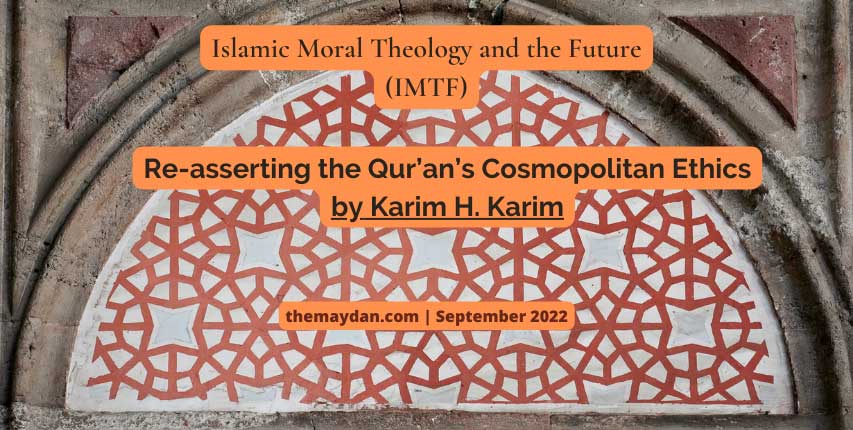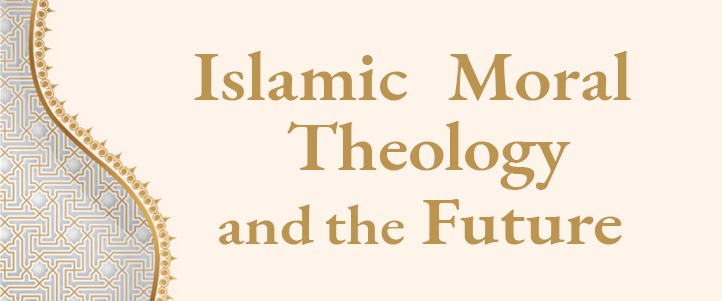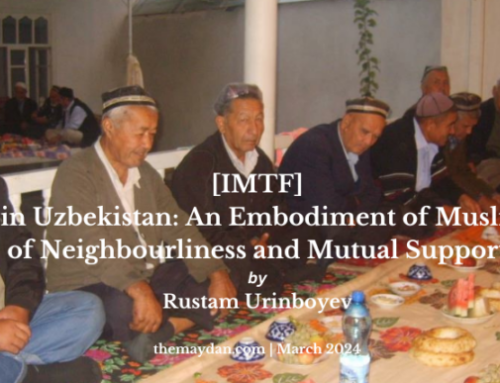
Re-asserting the Qur’an’s Cosmopolitan Ethics
The Prophet Muhammad’s open and outward-looking worldview has been constricted over centuries into insular dogmas that circumambulate increasingly tighter circles. Contemporary extremists, particularly, seek to hold believers hostage in narrow confines. The Prophet’s establishment of the umma encompassed Medinan Jews; it was later limited only to those pledging themselves to Islam. The umma has grown to be a world-wide religious community; however, not all who declare themselves Muslims are embraced.
Authors of the first set of essays in this project on the ethics of community, community support, and community formation agree that Islamic ethics promote goodness (iḥsān) and neighborliness (jiwār) towards all humanity. The Qur’an ushered in a particular religious vision that was embedded in a larger context. Its cosmopolitan spirit valued the goodness in other monotheistic believers: Jews, Christians, Sabeans (Q 2:62). As they traveled beyond Arabia, Muslims came across additional religious paths: Zoroastrians, Buddhists, Hindus. However, ways of relating to neighbors have differed, even between Muslims. The borders between self and other are policed on a shifting scale. Some Shias do not consider the leadership of the three Rashidun Caliphs before Ali to be legitimate and some Sunnis do not consider the Shia to be Muslims. Twelvers, Ismailis, Zaydis, Alawis, and Druzes are considered part of the fold in some circumstances but not in others. And Ahmadis are often left out in the cold. Ethnic, cultural, linguistic, and national differences are additional barriers to interaction despite the Qur’an’s exhortations to rise above them (5:48, 30:22).
[The Qur’an’s] cosmopolitan spirit valued the goodness in other monotheistic believers: Jews, Christians, Sabeans (Q 2:62). As they traveled beyond Arabia, Muslims came across additional religious paths: Zoroastrians, Buddhists, Hindus. However, ways of relating to neighbors have differed, even between Muslims. The borders between self and other are policed on a shifting scale.
Enes Karić’s IMTF essay in the Maydan notes that stories about Jewish and Christian figures were historically treated by Muslims as their own. Multireligious societies under Muslim aegis held a moral ethos that overlapped among people of different faiths. Islamic cosmopolitanism made possible such intersecting pluralist societies. Karić laments that international politics have led many contemporary commentators of the Qur’an to exclude narratives in which other religions’ leaders are models for Muslims. Whereas minorities have been steadily leaving majority-Muslim countries in recent decades, the very presence of their communities and institutions for over a thousand years are resounding testaments of traditional Islamic cosmopolitanism. Marshall Hodgson termed them “Islamicate” peoples, who practiced their respective religions and thrived under most Muslim governments. When the Almohads threatened Jews in Muslim Spain, Maimonides, a pre-eminent Jewish scholar, went not to Europe but to Muslim North Africa like many of his co-religionists. He eventually became an Ayyubid court physician and leader of Cairo’s Jewish community. By contrast, the atrocities that Daesh unleashed on Yazidis in 2014 were antithetical to the Qur’anic cosmopolitanism that had helped preserve this very old religious community in Iraq (although not without occasions of Muslim persecution).
“Letter Concerning Toleration” (1689), an early Enlightenment document by John Locke (who, ironically, was involved in the slave trade) entreated European monarchs to renounce mutual Protestant-Catholic persecution. He lamented that while they were conducting “inhumane cruelty” against their fellow co-religionists, Christians were protected in Muslim realms. However, Muslim-majority states now fare poorly in the treatment of religious minorities. Some have not ratified the Universal Declaration on Human Rights – partly due to the prohibition of apostasy in dominant Islamic discourses. Abdullahi An-Na‘im, a prominent sharīʿa scholar, has proposed that the legal concept of apostasy be abolished by prioritizing the Qur’an’s message of universal solidarity over its verses regarding Muslim solidarity. This approach is broadly resonant with the contemporary Muslim thought of Seyyed Hossein Nasr, Farid Esack, and Reza Shah-Kazemi, who have written extensively on engaging with people of other faiths.
The idea that Muslims constitute a self-contained entity insulated from other peoples only became part of dominant discourses about Islam over time. Constructed binaries like the Dār al-Islām (“Abode of Islam”) versus the Dār al-Ḥarb (“Abode of War”) clearly fly in the face of reality. Muslims, like all others, have necessarily had to interact across faiths and cultures. The Prophet Muhammad counselled his followers to seek knowledge in the furthest reaches of the world. Openness to other civilizations was vital to the religious, cultural, and intellectual growth of Muslim societies, which went on to make substantial contributions to the store of human learning. Early Muslim intellectuals studied at places like Jondishapur, the Sassanid center of scholarship where Persians, Greeks, Indians, and Romans also trained in medicine, philosophy, theology, and science. Ibn Sīnā (Avicenna) built substantially on the work of physicians of several cultures to compose The Canon of Medicine (al-qānūn fī al-ṭibb), a 14-volume medical encyclopedia that was a standard medical text in Muslim and European universities until the 18th century.
Openness to other cultures also provided for the intellectual flowering of the Islamic faith itself. It comes as a surprise to contemporary Muslims that certain aspects of their religion that have become integral to its structures resulted from engagement with neighboring civilizations. The only textual Islamic sources that emerged from the Prophet Muhammad’s time were the Qur’an and the Hadith. Seventh century Arabia’s inhabitants were not formally learned in the natural or the human sciences. In the next few centuries, Muslim scholars developed the basis of Islamic law (fiqh), theology (kalām), and philosophy (falsafa). Producing these bodies of work required tools of analysis as well as systems of logic, reasoning, and categorization that were acquired from adjacent cultures. The waqf endowment system and the architectural structures of the arch and the dome, now viewed as characteristic of Muslim design, benefitted from Byzantine influence. Prayer beads (subḥa / tasbīḥ), which have become integral to aspects of Islamic worship, were most likely derived from the devotional practices of Christianity or Indian religions, whose adherents had used them prior to the advent of Islam. Even foundational religious ideas such as good and evil and the existence of angels are found outside of the Abrahamic traditions in ancient Iranian religions. Such transfers of concepts between neighboring peoples are among the most consistent features of human history but are either underemphasized or completely denied in dominant discourses to construct images of pristine, self-contained, and monolithic religions. Adherents are inculcated with notions of the absolute separation between self and other.
However, material examples of religious intersections from the past and the present speak of fluid interactions. Included in the artifacts of medieval Muslim art with Christian subject matter are a Syrian flask in the Louvre’s collection and the “d’Aremberg basin” in the British Museum. Byzantine design features are present in Jerusalem’s Dome of the Rock mosque and Damascus’s Umayyad Mosque. The centuries-old Church of Agios Nikolaos in Crete, which holds a Christian relic, has preserved both a Greek Orthodox bell tower and an Ottoman minaret. The baptismal font of the prominent “Mosque Church” in Pécs, Hungary (previously under Ottoman rule) is placed in a miḥrāb where the shahada (Islamic confession of faith) is inscribed. In his book Kitāb al-yanābīʿ, the medieval Ismaili philosopher Abū Ya‘qūb al-Sijistānī conceptualized the Christian cross’s four ends as symbolizing lā ʾilāha ʾillā Allāh, the first sentence of the shahāda.)
Christians and Muslims regularly make pilgrimage to the Maronite Shrine of Our Lady (the Virgin Mary) in Harissa, Lebanon. Copts and Muslims celebrate the ancient Egyptian spring festival of Sham al-Nasīm, which is held on Easter. Many Shias and Sunnis in Iran, Central Asia, Afghanistan, South Asia, the Caucasus, the Balkans, Kurdish areas, and Crimea (along with certain Sephardic groups in Israel) commemorate Nowrūz, the Zoroastrian calendar’s New Year. Salafis, Taliban, and Iranian hardliners have sought to ban the festival but Nowrūz celebrations are resilient and are viewed as being part of religious practice by some Muslims who observe them. Despite periodic efforts to cleanse Muslim thought of what are considered to be alien ideas, facets of ancient beliefs knowingly or unknowingly remain interwoven in Islamic worldviews. Scholars have commented on the Qur’an and Hadith over many centuries using modes of thought that have other origins. This is natural to the unfolding of ideas in all civilizations.
Sufi philosophies like Suhrawardī’s Ḥikmat al-Ishrāq (“Wisdom of Illumination”) overtly make links between Zoroastrian, Neoplatonic, Jewish, Christian, and Islamic traditions. They uphold the Qur’an’s universalist and cosmopolitan openness to manifest a borderless spiritual neighborhood. One does not cease to be Muslim by engaging in spiritual goodness (iḥsān) with one’s neighbors. The ultimate religious objective in Sufi modes of thought is knowledge of the absolute truth (ḥaqīqa) and knowledge of higher realities (maʿrifa) that supersede the exoteric aspects of any particular religion.
We see extensive interactions across South Asian faiths, many of whose followers have found ways to relate well with each other. Indic religions’ apparent polytheism would seem to be averse to Islamic monotheism; however, certain forms of Muslim thought have discerned the Hindu concept of Brahman (also verbalized as “Aum”) to be a singular reality underlying multiple divine figures.
We see extensive interactions across South Asian faiths, many of whose followers have found ways to relate well with each other. Indic religions’ apparent polytheism would seem to be averse to Islamic monotheism; however, certain forms of Muslim thought have discerned the Hindu concept of Brahman (also verbalized as “Aum”) to be a singular reality underlying multiple divine figures. Ambigrams that combine the writing of “Allāh” in Arabic and “Aum” in Sanskrit have sought to express felicity between the two understandings of monotheism.
Indian society experienced considerable ferment beginning in the twelfth century when Bhakti (a Vedic mode of populist worship) and Sufi movements intermingled. Saintly figures such as gurūs, sants, bābās and pīrs were interested in spiritual truth rather than religious orthodoxies. Several groups emerged over time, including Kabīr Panth, the Bauls, and the Sai Bābā movement. These traditions resulted from pluralist engagements of Indic-Islamic thought and practice. Many individuals with affiliations to the groups have fluid and dynamic identities which are not seen as exclusively Hindu or Muslim. However, the subcontinent’s tendencies of religious hybridity have been concealed by dominant socio-political and media discourses that present individuals in essentialized religious categories.
Lyrical genres like granths, shabads, bānīs and gināns constitute shared literatures of gurū-pīr traditions. Muslim preachers adopted Indic languages, symbols, and modes of worship to produce musical forms that intersect in the devotions of several contemporary communities in South Asia. Chishtī Sufis’ religious poetry is similar to Bhakti compositions. Gurū Nanak incorporated the shabads (hymns) of the Muslim saint Bābā Farīd into the Sikh holy book Gurū Granth Sāhib. Satpanth (“Path of Truth”) is an expression of Da’wat al-Haqq (“Invitation to Truth”), a Shia movement that originated in Arab and Persian lands. Its core beliefs were indigenized into the subcontinent’s religio-cultural contexts and were expressed through Indic myth and symbolism in gināns. Over time, groups of Satpanth adherents adopted separate, essentialized identities as Ismailis, Twelvers, Sunnis, and Hindus.
Monolithic census categories of British colonial authorities, which pigeonholed persons as solely “Hindu,” “Muslim,” “Sikh,” “Sunni,” “Shia” etc. were a factor in ossifying the spiritual neighborhood of fluid selves that had co-existed with dominant orthodoxies.
Monolithic census categories of British colonial authorities, which pigeonholed persons as solely “Hindu,” “Muslim,” “Sikh,” “Sunni,” “Shia” etc. were a factor in ossifying the spiritual neighborhood of fluid selves that had co-existed with dominant orthodoxies. The essentialized identities were further reinforced through the Hindu and Muslim representational politics leading to the sub-continent’s partition. The growth of extremist Islamist and Hindutva (the ideology promoting Hindu hegemony) movements have pushed the hybrid religious manifestations further into the background. Yet such fluid expressions of the self survive: some groups which are formally Muslim continue to invoke Vedic figures and large numbers of Hindus supplicate at the shrines of Islamic saints.
Dominant societal, academic, and media discourses tend to hold adherents of various religious communities as being completely separate. However, occasional confessional overlaps do appear in some media. Popular television programs in Turkey and Pakistan, respectively, show historical Sunni characters invoking the Prophet’s family (Ahl al-Bayt) and Sunni qawwālī singers beseeching Ali’s assistance – both characteristically Shia devotional practices. Indian film’s history of depicting Hindu-Muslim relationships includes profound expressions of religious interaction. However, Hindutva’s pressure on Bollywood to deliver darker Muslim characters has grown. The Internet provides enriching knowledge about religious neighbors, but some social media sites have also become bastions of intolerance.
Contemporary Muslims have a vital role to play in asserting spiritual neighborliness globally. The Prophet affirmed an open-hearted cosmopolitanism towards other paths seeking truth. Many of his followers have strived over the centuries to uphold this vision and resist calls to pursue insularity. Karić reads Qur’an 2:208 as “Enter into peaceful neighborliness (al-silm)” – “silm” being a cognate term of “Islām.” This Qur’anic scholar’s translation underlines the multi-layered substance of Islam that includes the fostering of harmony among peoples. In this lies a profound message for those who dogmatically hold neighbors to be alien in today’s fractious but interdependent world.
Karim H. Karim, Chancellor’s Professor at Carleton University in Ottawa, Canada, has served as Director of the Carleton Centre for the Study of Islam, the Institute of Ismaili Studies (UK), and Carleton’s School of Journalism and Communication. He has held visiting positions at Harvard, Simon Fraser, and Aga Khan universities and has delivered distinguished lectures around the world. Dr. Karim’s writings have been extensively cited and translated into several languages. His publications include the co-edited volumes Re-Imagining the Other: Culture, Media, and Western-Muslim Intersections and Engaging the Other: Public Policy and Western-Muslim Intersections. He received the inaugural Robinson Prize for the critically acclaimed book Islamic Peril: Media and Global Violence. Professor Karim’s most widely-read article is the co-authored “Clash of Ignorance,” which presents an incisive critique of the clash of civilizations thesis. His current research examines religious intersections, particularly in Indic-Islamic contexts. Karim has been honored by the Canadian government for fostering collaboration between religious communities.





